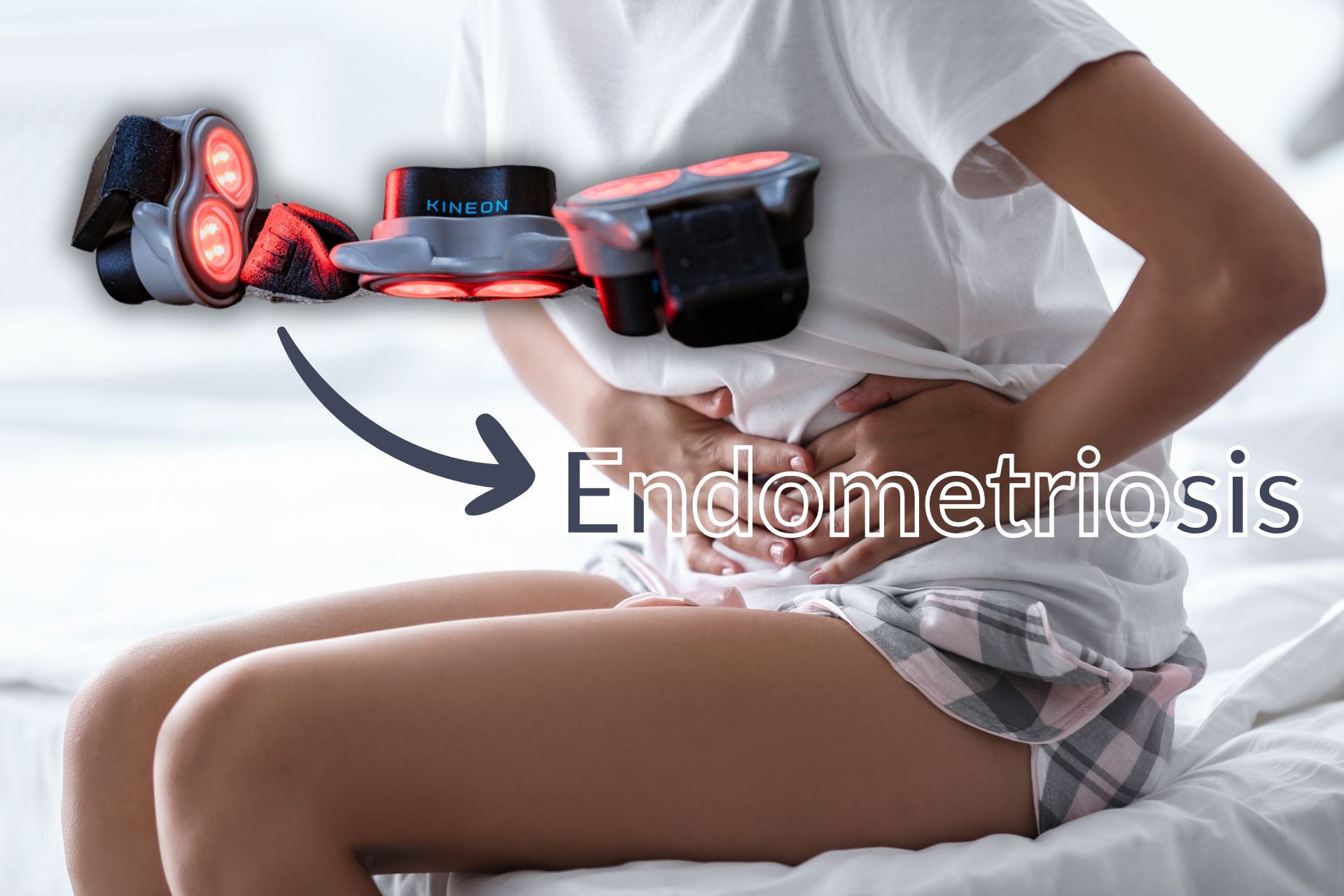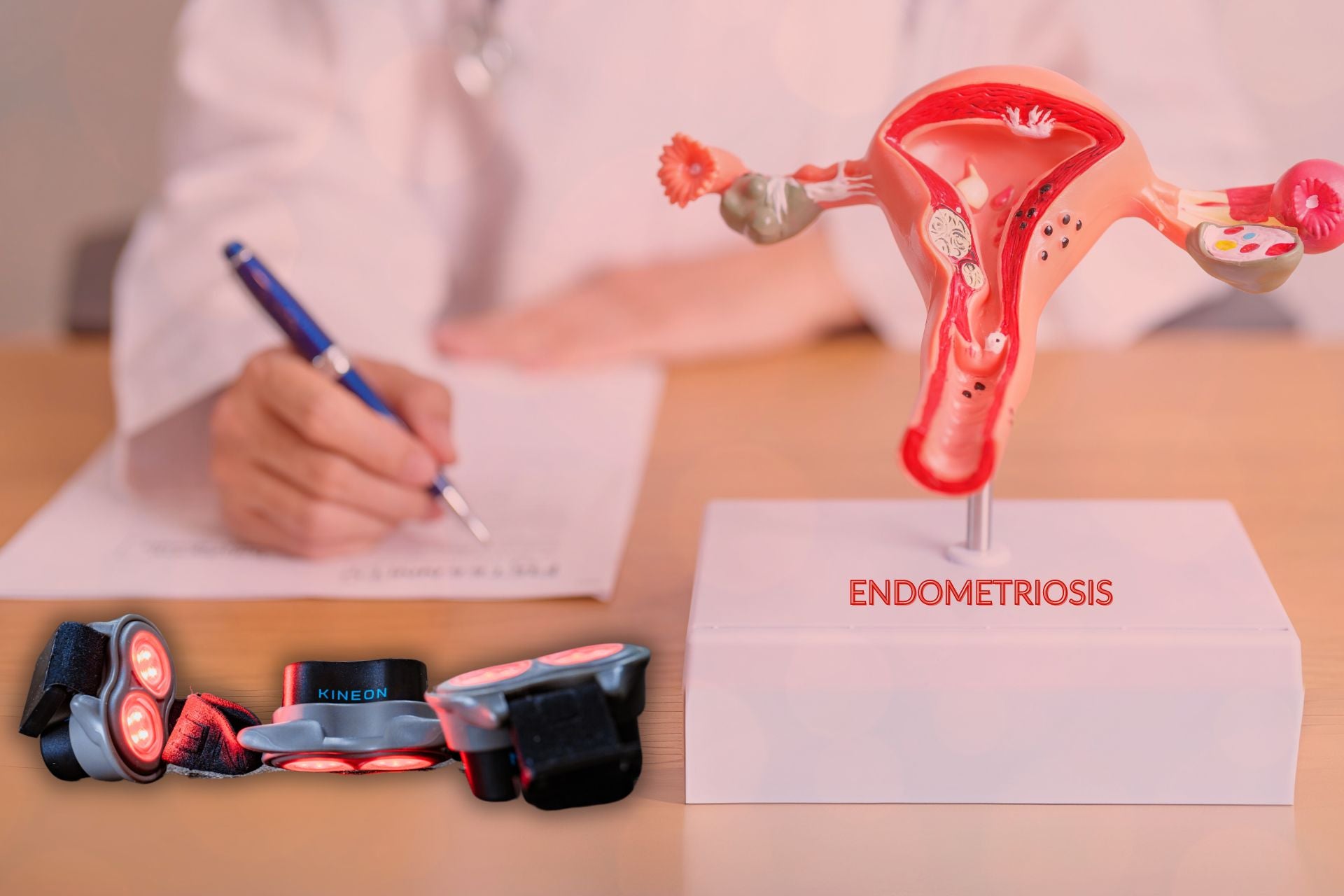
Endometriosis and Red Light Therapy
Share
Intense cramps, bloating, and chronic pain are just three symptoms of endometriosis. The pain can be debilitating, making going to study or work feel impossible at the height of its flare-ups.
While it often goes unspoken about, in contrast to other long-term conditions like diabetes, arthritis, or even epilepsy, it affects more than 11% of American women aged between 15 and 44.
Endometriosis is a hormone-dependent and inflammatory disease, characterized by the presence and growth of endometrial tissue outside the uterine cavity. It can significantly impact quality of life, with typically long diagnosis wait times and little to no support for a cure.
Laparoscopy surgery is a commonly used technique to help those who are suffering from the condition, as it involves the removal of the endometriosis tissue. This isn’t a catch-all though, as the tissue can reoccur some time after the operation has taken place.
While solutions for living with this aren’t extensive, that’s not to say there aren’t treatments or therapies that work. We’re looking at the influence of red light therapy (also known as photobiomodulation) for endometriosis and how this can potentially ease pain and discomfort.
How Does Red Light Therapy Help Endometriosis?

When looking for endometriosis treatment, you’re likely seeking some support with the pain and inflammation as these two symptoms are highly present in this condition.
Pain Relief
One of the most well-documented and widely recognized benefits of light therapy is its pain-relieving capabilities. Soreness in your stomach or lower back is often prominent when you’re in the throes of endo or post-surgery and red light can reduce this by promoting the body’s natural pain-killing endorphins.
This helps you to find that much-needed relief without the risk of complicated surgeries or medication. Typically, the more red light therapy sessions you have, the longer the pain relief.
Reduces Inflammation
Endometriosis is a chronic inflammatory condition, driven by the hormones estrogen and progesterone. It leads to inflammation and scar tissue in the pelvic area which is where the power of light can come in.
Red light has anti-inflammatory effects due to the modulation of cellular processes and immune responses. This reduction in inflammation will help with the pain felt in your stomach too and can increase mobility.
Wound Healing After Surgery
If either of the two possible surgeries for endometriosis is carried out (laparoscopy and hysterectomy) there will be a period of rest that is required with wounds to heal. When red light therapy is applied to the skin, it triggers cellular changes that accelerate the body’s natural healing mechanisms. This speeds up wound healing.
The Science Behind Red Light Therapy and Endometriosis

Among its numerous health benefits, red light therapy can be effectively used to ease the symptoms of menstrual cramps.
One study found that poor blood flow causes the constriction of the uterine vessels causing pain in women with primary dysmenorrhea.
Red light therapy treatments can offer pain relief to those women by triggering the release of nitric oxide, a compound made by your body that improves blood flow to damaged or diseased tissues.
Nitric oxide may also help manage painful menstrual periods because it's involved in the mechanism of pain generation and transmission throughout the central and peripheral nervous systems.
This study compared the use of combined oral contraceptives (ethinyl estradiol and desogestrel) and red light therapy for menstrual relief and found that they both achieved clinically meaningful levels of pain reduction.
Another study found that using a red light therapy device for the duration of the menstrual cycle not only reduced menstrual cramps but was also found to be a safe and effective alternative to the use of analgesics in Korean women with dysmenorrhea.
How Does Red Light Therapy Work for Endometriosis?

In a situation where the pain can feel never-ending and mobility is hindered, red light therapy offers a non-invasive and affordable treatment option for dealing with this long-term condition.
Here are just three ways in which red light therapy works for endometriosis…
Reduces Proinflammatory Neuromediators
Nerve fibers themselves have an active role in the mechanism of inflammatory pain by secreting proinflammatory neuromediators. This mechanism is called neurogenic inflammation and is seen in several painful conditions, like complex regional pain syndrome, migraine, and arthritis.
All of these conditions have seen substantially improved outcomes, in the form of reduced pain and inflammation, from photobiomodulation treatments.
Menstruation Causes Innate Immune Activation
Similar to endometrium, endometriotic lesions are governed by endocrine cycles, and cyclic bleeding occurs. Menstruation has many features of an inflammatory process and, during the late secretory phase, an increased number of macrophages and activated mast cells is observed, which continues during menstruation.
The concentration of innate immune cells is increased in the peritoneal fluid of women with endometriosis compared with controls. Red light therapy is known to modulate the immune response, particularly through the role of pro- vs anti-inflammatory cytokines.
Balances and Improves Vaginal Biome
Photobiomodulation (PBM) is a therapeutic approach that uses low-level light to stimulate healing and reduce inflammation. It has been studied for its potential to improve the vaginal microbiome too.
The vaginal microbiome, which consists of various bacterial species, plays a crucial role in maintaining vaginal health, preventing infections and women’s overall health. A balanced vaginal microbiome is associated with a healthy acidic environment that prevents the growth of harmful bacteria.
Disruptions to this balance can lead to conditions such as bacterial vaginosis and yeast infections. PBM can enhance the vaginal microbiome by reducing inflammation and promoting tissue repair, which can help maintain the balance of bacteria.
The Studies Behind Red Light Therapy and Endometriosis

Women’s health has long been put on the back burner in the world of research and science, but there has been a surge in endometriosis research over the last couple of years following decades of underfunding.
It’s highly likely that understanding will deepen even further every time a new study is completed, with the potential for new diagnostics and treatments. We’ve outlined some key studies that look to analyze the influence and impact that red light therapy can have on endometriosis.
Below, we’re sharing endometriosis studies and our in-house, photobiomodulation expert, Aaron Rogers tells us about the study, key findings, strengths, limitations and why we choose this study, of all of them, to share with you, today.
Study 1: Pathogenesis of Endometriosis: Interaction Between Endocrine and Inflammatory Pathway
Read the full study.
Despite its prevalence, the etiology of endometriosis has always been poorly understood. This study aims to gain a further look as the researchers attempted to synthesize the “growing evidence that hormonal and immune factors conspire to activate a local inflammatory microenvironment that encourages endometriosis to persist and elaborate mediators of its two cardinal symptoms: pain and infertility.”
While this study doesn’t focus on photobiomodulation, it provides a background for why light therapy can help.
Key findings about endometriosis and red light therapy:
- The etiology underlying endometriosis is still somewhat unclear
- There is an immune function aspect to endometriosis
- The science on endometriosis continues to advance and is an active field of study
Study strengths:
This study sets the stage for the immune and inflammation aspects of endometriosis, suggesting a path towards treatment.
Study limitations and challenges:
This study thoroughly covers the background on causes of endometriosis but does not discuss treatments. This needs to be explored in other articles. Further research on the causes is required, as is mentioned in the article.
Our thoughts on Pathogenesis of endometriosis: Interaction between Endocrine and inflammatory pathway
We find this article to be a comprehensive background on immune and endocrine factors in endometriosis. These studies suggest the mechanism by which photobiomodulation can affect this disease.
Study 2: Transvaginal Photobiomodulation for the Treatment of Chronic Pelvic Pain: A Pilot Study
Read the full study.
Chronic pelvic pain has long been a common and truly debilitating condition that affects millions of people worldwide, but treatment so far has been ineffective. The researchers of this study aimed to look at whether transvaginal photobiomodulation can reduce pain in women who suffer from chronic pelvic pain.
They included 13 women who each completed nine treatments, with questionnaires and then analysis from clinicians being completed at several stages.
Key findings about endometriosis and red light therapy:
- Transvaginal treatment requires the use of a laser-based probe.
- Pain was significantly reduced in women with chronic pelvic pain
- Positive effects were seen after only one week
Study strengths:
This study showed very clearly that pain is reduced with the use of intravaginal red light therapy. Statistics are shown clearly, and this team is continuing to research the topic. They also have a product that is in clinical use, thereby motivating further research.
Study limitations and challenges:
The metrics from this study are quantitative, such as pain scores. While this is standardized and trustworthy, it is always beneficial to have quantitative metrics as well. Another limitation is that this transvaginal approach requires a visit to the clinic for treatment, which brings both cost and discomfort.
Our thoughts on Transvaginal Photobiomodulation for the Treatment of Chronic Pelvic Pain: A Pilot Study
We find that this study clearly shows the efficacy of red light therapy for the treatment of chronic pelvic pain, including endometriosis. However, this study lacks quantitative metrics, and the treatment strategy is inconvenient.
Study 3: New Insights into Photobiomodulation of the Vaginal Microbiome—A Critical Review
Read the full study.
Published in 2023, this study looks at photobiomodulation as a treatment option for the vaginal microbiome (VMB). There has been some attention around the microbiome over the last few years, mostly focused on the gut, with the application of PBM having promising results on this.
Researchers in this study have focused on the VMB and the potential mechanisms and effects of this from the use of photobiomodulation.
Key findings about endometriosis and red light therapy:
- A healthy vaginal microbiome is key for limiting the growth of harmful bacteria and is correlated to fertility topics
- Nitric oxide, a molecule that undergoes photodissociation in the mechanism of PBM, has been shown to modulate the vaginal microbiome (Regulation of Vaginal Microbiome by Nitric Oxide)
- Red light therapy has been shown to affect the symbiosis of certain microorganisms implicated in a healthy vaginal microbiome.
Study strengths:
This study provides a thorough background on both photobiomodulation and the vaginal microbiome. Along with this background, the ways in which photobiomodulation could have an impact on the vaginal microbiome are explored in this article.
Study limitations and challenges:
A key limitation of this article is that it is purely a review article, meaning no experiments have been done, instead ideas are being explored.
Our thoughts on the New Insights into Photobiomodulation of the Vaginal Microbiome
We think this article provides a great theoretical framework that can be further tested with pilot and clinical studies.
As personalized medicine becomes more affordable and widespread, it seems likely there will be an explosion in interest and knowledge surrounding the vaginal microbiome, similar to what has been seen with the gut microbiome.
Along with this, there will continue to be more exploration of the relationship between these microbiomes and how they affect other parts of the body, such as the gut-brain axis. While still somewhat unknown territory, we expect exciting discoveries on this front!
Study 4: The Application of Intravascular Laser Irradiation of Blood for the Correction of the Immune Disturbances in Patients Presenting With Chronic Endometritis
This controlled trial, carried out in Russia in 2016, looks specifically at the features of the immune disturbances in people with chronic endometriosis and to see if these can be corrected with the use of low-intensity intravascular laser radiation of blood.
30 women were included and divided into two groups, one being treated solely by pharmacotherapy while the other group was given standard therapy supplemented by intravascular laser irradiation of blood. This included 25-minute sessions daily, over the course of seven days.
Key findings about endometriosis and red light therapy:
- Endometriosis recovery was improved with the use of intravascular red light therapy
- Study compared pharmacological intervention alone vs. pharmacological with intravascular red light therapy
- Shows an effect on immune function, measured cytokines and other molecules with immunoassays.
Study strengths:
This study is innovative in its strategy, intravascular photobiomodulation is fairly uncommon. Additionally, the use of immunoassays provides qualitative evidence for immune modulation.
Study limitations and challenges:
The use of intravascular photobiomodulation presents an unattractive application strategy, as this is both invasive and would require a visit to a clinic. Additionally, they only compared use with a pharmacological agent, so it would have been interesting to see the comparison of PBM+no drug and just a placebo.
Our thoughts on The application of intravascular laser irradiation of blood for the correction of the immune disturbances in patients presenting with chronic endometritis
We find this study to use a strange strategy for application, but it shows that it still has a positive effect on local immune function in the vagina and a positive effect on endometriosis. Other studies show that these positive results can be achieved with intravaginal approaches as well.
Study 5: Has the Time Come to Include Low-Level Laser Photobiomodulation as an Adjuvant Therapy in the Treatment of Impaired Endometrial Receptivity?
Read the full study.
This study looks specifically at the effect of low-level laser therapy to enhance the “proliferation and gene expression of in vitro cultured endometrial cells.” Both single and multiple exposures to this form of light therapy were analyzed in the study and in study groups, with the cellular response being measured by viable cell numbers and surface area.
Key findings about endometriosis and red light therapy:
- Red light therapy affects endometrial cell proliferation
- Gene expression is affected by red light therapy
- Multiple treatments of red light therapy outperformed single and especially no treatments
Study strengths:
This study looked at gene expression using a type of PCR, which is a very powerful tool for gaining fundamental understanding.
It was shown that red light therapy increased the gene expression of various endometrial receptivity genes, and also increased the expression of PTEN, a tumor suppressor gene. Additionally, red light therapy significantly improved the cell count (proliferation) of endometrial cells.
While this could seem counterintuitive in regards to treating endometriosis, it has been proposed that endometriosis could stem from endometrial cell dysfunction, which could be corrected with healthier endometrial tissue.
Study limitations and challenges:
As with any in vitro study, a key limitation of this study is that it tells us great information about how these endometrial cells respond to red light therapy, but this is not necessarily indicative of the response that will be seen in vivo.
Another issue is that unfortunately this study is behind a paywall, so one needs to obtain the article to read it.
Our thoughts on Has the time come to include low-level laser photobiomodulation as an adjuvant therapy in the treatment of impaired endometrial receptivity?
While this article is not directly on endometriosis, the function of endometrial cells and endometrial tissue is directly at play.
The work done here shows that red light therapy directly affects endometrial cell proliferation and gene expression. An interesting and exciting nugget of information for the author was the effect seen on the gene expression of PTEN, a tumor suppressor gene.
This seems like a great avenue for further cancer research of red light therapy. There is clearly a need for further research with red light therapy and endometrial tissue, both in vivo and clinical.
Key Takeaways for Women Suffering With Endometriosis
- Menstruation is an inflammatory process that can trigger wider nervous system inflammation
- PBM has been shown to improve pain and inflammation and reduce the duration and severity of menstrual cramps
- PBM reduces the inflammatory markers that cause much of the discomfort of endometriosis and menstrual cramps
- PBM can help improve balance in the vaginal biome and help avoid yeast infections and bacterial vaginosis
- Photobiomodulation is emerging as a safe and effective therapy for many musculoskeletal disorders, including myofascial pelvic pain
Endometriosis and Red Light Therapy: Your Questions Answered
Is red light therapy helpful for endometriosis?
Yes! Red light therapy can absolutely help treat the symptoms and causes of endometriosis. In this article, we share research and studies to support the impact of red light therapy for endometriosis.
How often should you use red light therapy on endometriosis?
One of the great things about red light therapy is that it can be used frequently without any adverse effects. Although the exact frequency of use depends on the specific condition being treated and the type of device being used, red light therapy is generally considered safe to be used every day or multiple times a week.
We wrote a full article on how often you can use red light therapy here.Can you use red light therapy to help reduce painful periods?
There’s good research on this topic! Here’s an article that compares a pharmacological approach to red light therapy.
Can you use red light therapy after laparoscopy?
Red light therapy can be used after laparoscopy as it’s fortunate to have nearly zero contraindications. It could even help with the resulting inflammation. As everyone’s situation is unique, you should consult with your doctor before starting any form of treatment post-surgery.
Can you use red light therapy after a hysterectomy?
Hysterectomy does not present a problem and red light therapy can be used following this procedure. Though, we recommend you consult your doctor.
For more articles on red light therapy and women's health, read:
- Red Light Therapy and Female Fertility
- Is Red Light Therapy Safe During Pregnancy?
- Push Presents She Will Actually Use
- How Red Light Therapy Can Help Alleviate Menopause Symptoms
- 5 Ways to Manage Swelling During Pregnancy

